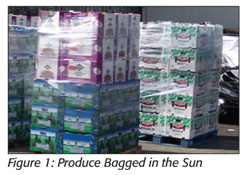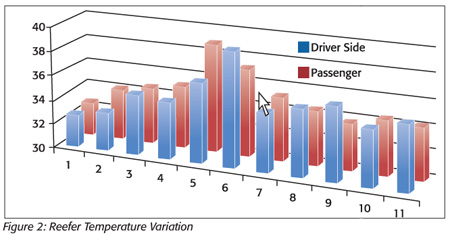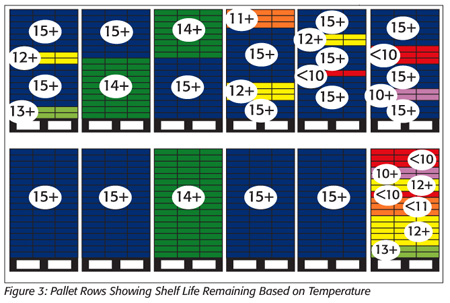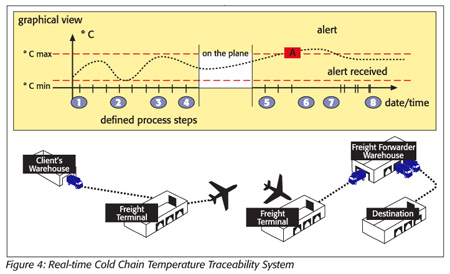It’s an old argument. Produce arrives at the distribution center or retail outlet and is rejected. When product appears to have been overheated or transported in an environment that was too cold, fingers start pointing. The farmer and distributor both claim to have shipped a “quality” product. There is no doubt in anyone’s mind that the trucker blew it somewhere along the line. The reefer was either out of control or the driver was asleep at the switch.
How can the trucking industry play a more active role in controlling delivery quality? Is it all really the fault of the farmers, or are the retailers “just too picky”? Is it really a trucking problem?
Long before Steinbeck’s East of Eden was published, most of us understood that cool temperatures keep food fresher (at least in appearance) and safer from bacterial growth. Remember the lettuce shipment that was lost when the train was sidetracked and the ice melted?
In today’s world, it is estimated that 30–50 percent of the produce grown on a farm is never eaten. Half of all the water, land, fertilizer, pesticide, fuel, labor and energy are being expended to grow food that is wasted. No wonder food is getting to be so expensive. Try a 50 percent-throughput yield in any industry on earth, and you will see good reason why that industry says it needs subsidies.
But what is really happening? A number of new technologies are helping us better understand and manage process and transportation temperature controls. The growing field of radio frequency identification (RFID), low-cost, recyclable sensor technology, can now provide us with real-time, real-location data that tell exactly what the product temperature is throughout the entire cold chain transportation process—and more.
Stalled Loads
 Let’s start with the obvious. This photo (Figure 1) was taken in Hawaii on a summer day. Bagged spinach and broccoli are sitting outside a very modern freight forwarder facility. The temperature was 92 °F that day. You might remember the Escherichia coli outbreak in bagged spinach a few years back. Bacteria grow rapidly in enclosed, warm, moist environments like plastic bags. If this shipment were contaminated, it is likely that many more people would get sick than if the temperature were carefully controlled.
Let’s start with the obvious. This photo (Figure 1) was taken in Hawaii on a summer day. Bagged spinach and broccoli are sitting outside a very modern freight forwarder facility. The temperature was 92 °F that day. You might remember the Escherichia coli outbreak in bagged spinach a few years back. Bacteria grow rapidly in enclosed, warm, moist environments like plastic bags. If this shipment were contaminated, it is likely that many more people would get sick than if the temperature were carefully controlled.
Reefer Temperature Variation
 Take a look at Figure 2 below. This is a temperature profile of the pallets in a trailer. The number 1 along the bottom of the scale shows the location of pallet 1. Pallet 11 is on the right. Blue pallets are on the right side of the trailer, red on the left. It doesn’t take much to realize that product in the middle of the trailer is hotter than product at either end or that there is fairly significant variation throughout the trailer load. Reefer temperature variation is a manageable trucking problem.
Take a look at Figure 2 below. This is a temperature profile of the pallets in a trailer. The number 1 along the bottom of the scale shows the location of pallet 1. Pallet 11 is on the right. Blue pallets are on the right side of the trailer, red on the left. It doesn’t take much to realize that product in the middle of the trailer is hotter than product at either end or that there is fairly significant variation throughout the trailer load. Reefer temperature variation is a manageable trucking problem.
Pallet Loading and Routing
 Figure 3 shows two rows of pallets, six pallets in each row. The colors depict remaining shelf life based on temperature controls. Pallet Row 1 (Figure 3, top) shows a lot of color (temperature) variety. This is a normal trucking setup where the grower unknowingly mixed warmer produce with produce that had been properly precooled and managed to deliver consistent quality. This is a typical first-in-first-out scenario. The distributor receiving produce on each pallet would probably break down the pallet contents for delivery to retail outlets or restaurants. The customer receiving short-shelf-life produce might have something unacceptable to say to the trucking company that delivered the produce.
Figure 3 shows two rows of pallets, six pallets in each row. The colors depict remaining shelf life based on temperature controls. Pallet Row 1 (Figure 3, top) shows a lot of color (temperature) variety. This is a normal trucking setup where the grower unknowingly mixed warmer produce with produce that had been properly precooled and managed to deliver consistent quality. This is a typical first-in-first-out scenario. The distributor receiving produce on each pallet would probably break down the pallet contents for delivery to retail outlets or restaurants. The customer receiving short-shelf-life produce might have something unacceptable to say to the trucking company that delivered the produce.
What is more important here is that the farm and trucker that moved Pallet Row 1 could not determine proper routing. In other words, the produce with the shortest remaining shelf life should have been delivered first and through the shortest route to give that retailer the most shelf life possible. The longer-shelf-life pallets (green and blue) could follow longer truck routes and still deliver longer remaining shelf life.
Pallet Row 2 (Figure 3, bottom) shows a set of pallets that reflect prioritization and control rather than mixing. Using temperature control data, the shipper is following first-expired-first-out (FEFO) principles to control delivered goods quality. The shortest-shelf-life pallet is at the rear of the truck and routed to the closest customer.
Farm Precooling
If we backtrack to the farm, it is important to note whether produce goes through a precool operation. Precooling generally involves a tunnel filled with gaseous coolant (e.g., nitrogen). Pallets or bins of recently harvested produce are put into the tunnel, the tunnel is cooled with the gas and then a temperature reading shows. There is ample data to suggest that the problem is that the middle of the bins or pallets generally cannot precool properly. Field and environmental heat is thereby trapped in the middle of the load. When the load goes into the trailer, this heat migrates out over time and results in a warming trailer. Both the produce’s and the trailer’s ambient temperatures rise, resulting in shortened shelf life, returns, rejects and lower yields.
Technology Offers Solutions
A few years back, neither the technology nor the data existed to help food and other supply chain players get better control over transportation processes. Intelligent routing for temperature-sensitive products (e.g., produce, frozen goods, pharmaceuticals, etc.) wasn’t well understood, and neither were shelf life, yield or FEFO issues.
The recent passage of the Food Safety Modernization Act will require all food supply chain players to step up and prove they can deliver safe quality rather than plaster “quality” slogans all over their advertising. Plastic pallets with electronic sensors will replace wooden pallets. Wood is not acceptable from a food safety perspective. It holds bacteria and cannot be cleaned.
 Real-time cold chain temperature traceability systems (Figure 4) using combinations of RFID, bar code, sensor and “cloud” data capture technologies will be shown to improve return on investment. After years of development through the long recession, these technologies are now cost competitive and available. Handheld and fixed readers help cut personnel costs. Data are available to all players via the Internet. Automated readings show if, when and where temperatures exceeded critical limits. Alerts are sent automatically to cellphones or email accounts.
Real-time cold chain temperature traceability systems (Figure 4) using combinations of RFID, bar code, sensor and “cloud” data capture technologies will be shown to improve return on investment. After years of development through the long recession, these technologies are now cost competitive and available. Handheld and fixed readers help cut personnel costs. Data are available to all players via the Internet. Automated readings show if, when and where temperatures exceeded critical limits. Alerts are sent automatically to cellphones or email accounts.
The trucking industry has never had a more timely opportunity to play its part in implementing and improving delivery control systems for temperature-sensitive goods. As a supply chain player, trailers can be outfitted with a global positioning system, global mobile communication systems and RFID sensors and readers that collect and supply real-time data to local and international integrated players. That’s a long way from East of Eden.
John M. Ryan, Ph.D. was the Administrator for the Hawaii State Department of Agriculture's Quality Assurance Division for the past several years and is currently the president of Ryan Systems, located in Canyon Lake, CA. He can be contacted at jryan@ryansystems.com.
The Impact of Temperature and Routing on Produce Shelf Life: Trucking’s Role in the Blame Game




